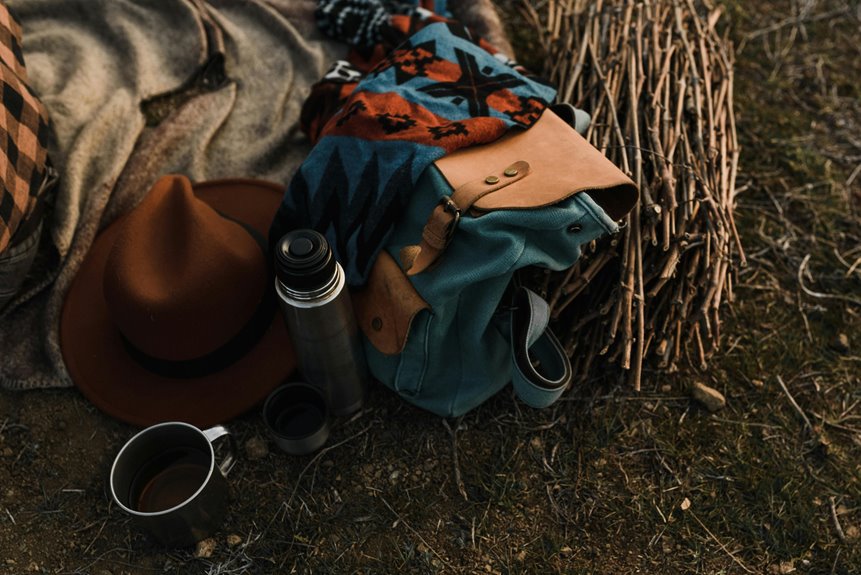When you’re gearing up for a hike or backpacking trip, choosing the right fabric can make all the difference in comfort and performance. Breathability matters more than you might think—it helps regulate your body temperature and keeps moisture at bay. But with so many options available, from natural fibers to high-tech synthetics, figuring out which fabric suits your needs isn’t always straightforward. Let’s explore what makes certain materials stand out for outdoor use.
Table of Contents
Key Takeaways
- Natural fibers like cotton, linen, and wool offer excellent breathability and moisture regulation for comfortable hiking wear.
- Lightweight synthetic fabrics such as polyester blends wick sweat quickly and dry faster, reducing chafing and overheating.
- Fabrics with odor control technologies inhibit bacterial growth, maintaining freshness during long backpacking trips.
- Waterproof breathable membranes like Gore-Tex and eVent balance protection from rain with moisture vapor transmission for comfort.
- Choose midweight or lightweight fabrics based on activity level and climate to optimize breathability and insulation on trails.
Natural Fibers: Comfort and Breathability in the Outdoors
Natural fibers like cotton, wool, and linen offer unmatched comfort and breathability when you’re hiking. You’ll appreciate cotton advantages such as its softness and natural moisture absorption, keeping you comfortable on cooler days.
However, cotton can hold moisture longer, so use it wisely. Linen breathability stands out, too, with its open weave allowing air to flow freely, which helps you stay cool during warm hikes.
Cotton retains moisture longer, so choose it carefully; linen’s open weave boosts airflow, keeping you cool on warm hikes.
Wool is another natural fiber that regulates temperature well, wicking moisture while providing insulation. When you choose natural fibers, you get fabrics that work with your body, ensuring comfort without overheating.
Just remember, these materials excel in breathability but might require extra care to dry quickly if they get wet on the trail.
Synthetic Fabrics: Durability and Moisture Management
Although synthetic fabrics don’t offer the same softness as natural fibers, they excel in durability and moisture management, making them ideal for hiking.
When you choose polyester blends, you get a fabric that wicks sweat quickly and dries fast, keeping you comfortable on long treks.
Nylon advantages include exceptional strength and abrasion resistance, so your gear holds up against rough trails and frequent use.
These fabrics also resist stretching and shrinking, maintaining their shape over time.
Plus, synthetic materials handle moisture better than many natural fibers, reducing chafing and helping you stay dry.
If you want reliable performance from your hiking clothes, synthetic fabrics like polyester blends and nylon provide the durability and moisture control that won’t let you down out on the trail.
Specialty Fabrics With Odor Control and Softness
Comfort and confidence on the trail come from fabrics that not only feel soft but also keep odors at bay. Specialty fabrics with odor fighting technologies help you stay fresh, even during long hikes.
These technologies actively inhibit bacterial growth, preventing unpleasant smells without sacrificing breathability. You’ll appreciate materials treated with soft touch finishes, which enhance comfort by giving garments a smooth, gentle feel against your skin.
Advanced fabrics fight bacteria and odors while staying breathable and soft against your skin for lasting comfort.
This combination of softness and odor control means you can focus on the trail without distraction. Whether you’re layering or wearing a single shirt, these fabrics deliver the comfort and freshness you need for extended outdoor adventures.
Choosing hiking gear made from these specialty fabrics guarantees you stay comfortable, dry, and odor-free mile after mile.
Waterproof and Breathable Membranes for Protection
While odor control and softness keep you feeling fresh, staying dry is just as important when you’re out on the trail. Waterproof technologies paired with breathable membranes let moisture escape without letting rain in, balancing protection and comfort. Understanding breathability factors helps you choose gear that keeps sweat from building up inside your layers.
| Membrane Type | Waterproof Rating | Breathability Factors |
|---|---|---|
| Gore-Tex | High (28,000 mm) | Excellent moisture vapor transmission |
| eVent | High (20,000 mm) | Direct venting for quick drying |
| Dermizax | Moderate (15,000 mm) | Stretchable, good moisture control |
Choosing the right membrane guarantees you stay dry, comfortable, and protected during your adventures.
Choosing Fabrics Based on Activity and Climate
When you plan your hiking gear, consider how your activity level and the climate affect your fabric choices. For high activity levels, like fast hiking or backpacking, choose lightweight fabrics with excellent breathability to wick away sweat and keep you dry. Lightweight fabrics reduce bulk and prevent overheating during intense exertion.
In contrast, for low activity levels or colder climates, opt for midweight or heavier fabrics that provide insulation while still allowing moisture to escape. Fabric weight plays an essential role in balancing breathability and warmth.
If you expect variable weather, look for fabrics that offer versatility—breathable yet insulating. Matching fabric weight to your activity level and climate guarantees you stay comfortable, dry, and protected throughout your outdoor adventure.
Frequently Asked Questions
How Do Fabric Breathability Ratings Get Tested and Measured?
You measure breathability testing by evaluating how well fabric moves moisture vapor through it. Moisture management tests involve simulating sweat and airflow, helping you understand how effectively the fabric keeps you dry and comfortable during activity.
Can Layering Different Breathable Fabrics Improve Overall Comfort?
Yes, layering techniques can boost your comfort levels by combining fabrics with different breathability and moisture-wicking properties. You’ll stay drier, regulate temperature better, and enjoy a more comfortable experience during outdoor activities.
What Fabric Blends Offer the Best Balance of Breathability and Durability?
You’ll find nylon blends offer great durability with decent breathability, while polyester blends excel in moisture-wicking and quick-drying. Choosing a fabric combining both guarantees you get breathable, durable gear that keeps you comfortable on your adventures.
How Does Fabric Weight Affect Breathability During Hiking?
You’ll find fabric thickness directly impacts breathability—thicker materials trap heat and moisture, hindering moisture management. Choosing lighter fabrics helps you stay cool and dry by allowing sweat to evaporate more efficiently during your hike.
Are There Eco-Friendly Breathable Fabric Options for Outdoor Gear?
You might be surprised—eco-friendly breathable gear does exist! Look for sustainable materials like organic cotton or recycled polyester, and always check for eco certifications. These options let you enjoy nature without harming it.
- Wholesale Scrim Fabric: A Sourcing Guide for Businesses and Large Projects - June 26, 2025
- The Pros and Cons of Cotton vs. Polyester Theatrical Scrim Curtains - June 26, 2025
- Can You Wash a Stage Scrim? A Step-by-Step Cleaning Guide - June 26, 2025





